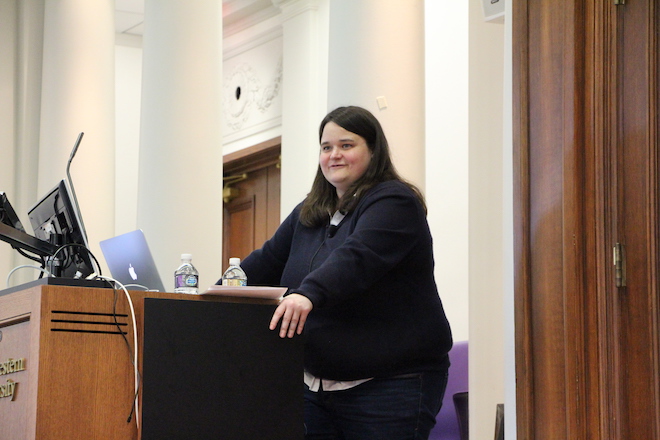The Upshot – The New York Times’ data analysis-focused section – uses high-level statistical understanding, advanced web development and human-centered design principles to make data understandable, relevant and even exciting. But, according to Upshot editor Amanda Cox, “we’re only playing with three things over and over again.”
On Wednesday, Cox boiled down the critical essence of her team’s work to three considerations: scale, context and patterns. Each of these aspects, she said, decided the composition and level of success of every piece created by her and her team.
The purpose of these methods is to create a meaningful experience with data for any person, regardless of background knowledge or context, Cox said.
Cox and her team use scale to make big ideas familiar. In referencing an article that used Monopoly pieces to describe donors, she said scale has power in data storytelling because it “connects to the knowledge that you already know . . . even if you have to give up a little bit of precision to put it in units that you feel like you understand right away.”
While Monopoly pieces may not fully convey the nuances of the donor dataset, they offer a familiarity to the reader that allows for immediate content connection and comprehension. That, Cox argued, is most important and the defining difference between data journalism and data-driven research.
Context, Cox said, is vital for a more grounded understanding of the content. This means designing data to match circumstance and offering a medium where consumers can easily comprehend complex information. Referencing a piece on Damien Hirst, an artist known for works like The Physical Impossibility of Death in the Mind of Someone Living, a shark in a formaldehyde-filled tank, she questioned a traditional data format in the context of his work. “Can you respect Damien Hirst with a line chart?” Cox asked.
Creating context is also vital to give personal meaning to data. In a story about the relationship between a family’s income and a child’s chance of attending college, The Upshot prompted readers to draw their approximation of the income-college connection.
“I want you to bring your expectations as the relevant context,” Cox said. Whereas the data is otherwise too simple to be interesting, injecting a personal touch enforces that the data is, in Cox’s words, “kind of crazy.”
Still, context (either personal or provisional) alone can’t provide all the meaning in a story. This is where Cox sees the power of patterns.
Patterns are present in just about any data set and can offer really interesting statistical insight, but if they’re not made clear to a reader, they’re powerless, Cox said.
“If you didn’t know to go looking for it and it wasn’t designed for you to go find it, I don't think you’re going to find it,” Cox said. “I think that's the power of patterns.”
Cox places the onus to identify patterns of interest on her team via annotation layers. This is the editorial insight that a content creator offers to add value to otherwise seemingly unimportant information.
“[We] are going to spend more time with [our] data than anyone looking at it, so [we] might as well tell [readers] what’s interesting,” she said.
Whether it’s a moving model of the mechanics of aerial skiing, two polar opposite interpretations of the same content side-by-side or a verbal explanation of the history of the Olympic Men’s 100-meter sprint, orienting a reader’s consumption of content can create a more meaningful experience.
“Traditionally, data is seen as a very high-level or more distant thing that’s exclusive to people who can understand it,” Weinberg sophomore Lexi Lu said. “By making it accessible to the public in an interactive or even fun way, it can reach a larger audience and, like what [Cox] said, have a bigger impact.”
Kelly Sheen, a postdoctoral researcher in the School of Communication, grapples with similar issues in making her work understandable for a larger audience. “We look at [the data], and it’s always interesting to us because it’s what we study,” Sheen said. “How do we make that digestible not only to people who want to know, but to a larger, broader audience?”

